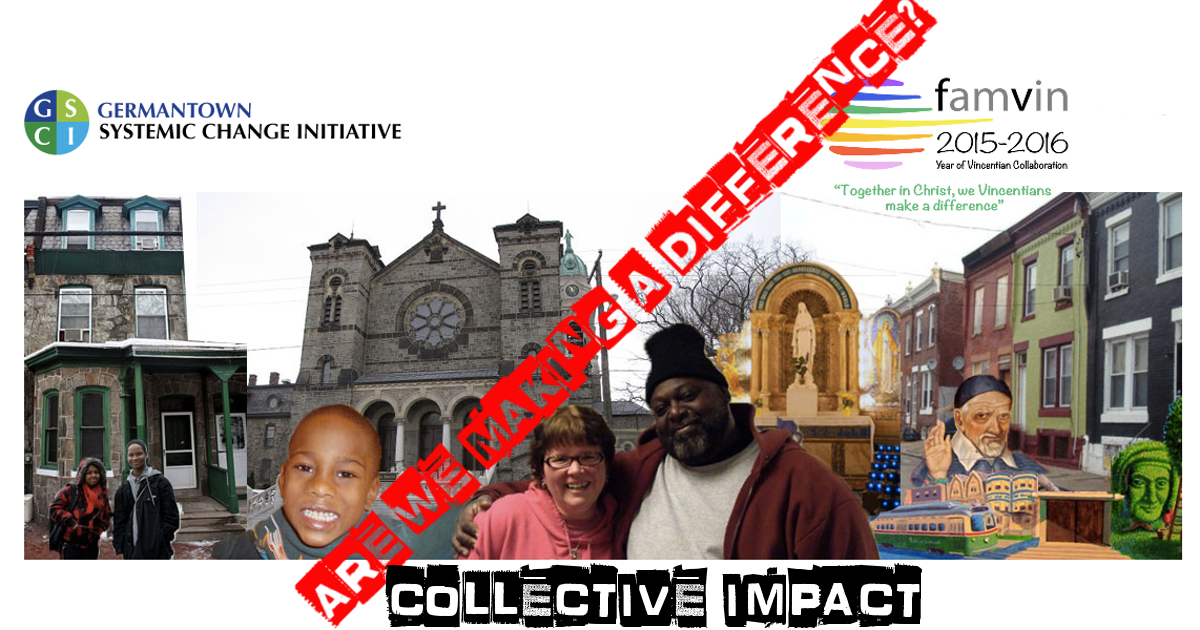Collective Impact in Systemic Change

by Mike Clark
Is there an impact — a collective impact – -that can be demonstrated in a systemic change initiative? The call to action for this year of Vincentian collaboration is “together in Christ, we Vincentians make a difference.” I believe we do make a difference, but what exactly is that difference? How do we know the difference we are making? Do we have evidence of this difference, or is it simply anecdotal? More importantly, are we actually making this difference together?
Seeking to make a difference
We have started to answer some of these questions in the Germantown section of Philadelphia. Impact Germantown, an initiative seeded and incubated by the Vincentian Family, seeks to enable low-income residents to move themselves beyond the structures that trap them in poverty’s extremely vicious cycle. We are building a system of collaboration and collective impact among service providers in the Germantown area in order to increase educational, housing, and employment opportunities. Germantown is a neighborhood rich in community assets and resources, yet over a quarter of the population lives below the poverty line (21,000 people).
In seeking to start a collaborative systemic change project in Philadelphia, we struggled initially in finding structure and organization. The willpower was there, and we had already-existing relationships with multiple social service and community-based organizations that had an appetite to see change in the community. The initiative sputtered a bit, until we stumbled on a playbook to operationalize collaboration and focus activity. This playbook would serve as something of a step-by-step guide to create a system for change, known in certain circles as Collective Impact.
Collective Impact rests on the notion that large-scale social change cannot be accomplished by one individual organization. The change we seek requires multiple actors, previously working in isolation, to build a common, measurable agenda. In Germantown, The DePaul Catholic School, Depaul USA, the Society of Saint Vincent de Paul, Face to Face, Inn Dwelling, and My Place Germantown are the direct-service organizations piloting this collective impact approach. We seek to impact 2,000 people by 2020, moving them above the poverty line.
In order to start a collective impact project, the first step needed is to start. Start with the resources/organizations/ministries in your area, and adapt the model to fit your local reality. Most collective impact initiatives start at a larger scale (city, county, countrywide), but we realized that we had a good number of organizations with which to pilot this approach, and could scale after we built the necessary infrastructure for the initiative. This allowed us to build the capacity necessary for our partners to measure impact in the first place, answering the question posed at the onset of this article:
How do we know we are making a difference?

© 2012 Stanford Social Innovation Review
Answering this question is fundamental to how we all operate, but it often is overlooked. We are traditionally very good at creating mission statements, when we also need a complimentary Theory of Change to evaluate whether or not we are being successful at carrying out that mission. Likewise, we have become adept at creating a strategic plan, otherwise known as a Shelf Document (because after completed it gets tucked away on a shelf, seldom revisited). A Logic Model is one tool to put your strategic plan into the daily operations of your organization, creating the measurable impact, or difference, you seek. If starting a collective impact initiative, these tools will be vital to building capacity for your partner organizations to understand the impact they are making in the first place. Only then can you begin to align that impact towards a common agenda. If pursuing collective impact, this is also important to keep in mind when building your shared measurement system. Creating Theories of Change, Logic Models, and a Shared Measurement System led to the realization, for example, that most of our organizations are having measurable impact on hard-to-employ adults. This is a great demographic to target as we seek to scale the initiative and have impact on the community at large.
Collective Impact is just one of many models for moving your community toward systemic change, a road map that can be adapted to fit your local reality. It shifts thinking from scarcity to abundance, from deficits to assets. Collective Impact serves as a playbook for making a difference, together.
 Mike Clark is the Executive Director of the Impact Germantown, a collective impact venture championed by the Vincentian Family in Philadelphia. Mike has advised faith-based communities in the areas of performance management, impact measurement, and impact investing. He has also developed social-innovation finance legislation for the state of New Jersey. Prior to his current role, he worked in a variety of roles in K-12 urban education in Philadelphia including strategy, resource development, and teaching. Michael also served as a Peace Corps volunteer in Bulgaria. He holds a Bachelors degree from the University of Scranton, and a Master of Public Administration from the University of Pennsylvania’s Fels Institute of Government.
Mike Clark is the Executive Director of the Impact Germantown, a collective impact venture championed by the Vincentian Family in Philadelphia. Mike has advised faith-based communities in the areas of performance management, impact measurement, and impact investing. He has also developed social-innovation finance legislation for the state of New Jersey. Prior to his current role, he worked in a variety of roles in K-12 urban education in Philadelphia including strategy, resource development, and teaching. Michael also served as a Peace Corps volunteer in Bulgaria. He holds a Bachelors degree from the University of Scranton, and a Master of Public Administration from the University of Pennsylvania’s Fels Institute of Government.
(Ed.: This developing project is a good one to watch and from which to learn. .famvin is watching and learning!)







0 Comments